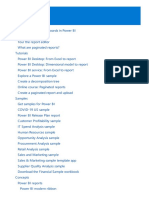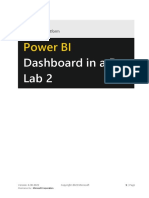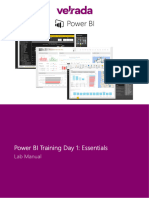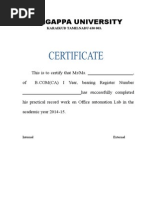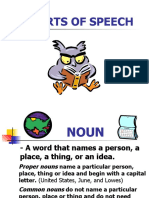Lab 3 - Data Visualization
Uploaded by
Delbert BeasleyLab 3 - Data Visualization
Uploaded by
Delbert BeasleyPower BI
Dashboard in a Day
Lab 3
Version 10.20.2023 Copyright 2023 Microsoft 1 |Page
Maintained by: Microsoft Corporation
Contents
Introduction ............................................................................................................................................... 3
Power BI Desktop ....................................................................................................................................... 4
Power BI Desktop – Data Visualization.................................................................................................... 4
References ............................................................................................................................................... 34
Version 10.20.2023 Copyright 2023 Microsoft 2 |Page
Maintained by: Microsoft Corporation
Introduction
This document is lab three out of five total labs.
Please continue to use your file after completing Lab 2. If you are joining the Dashboard in a Day at this
point or were unable to complete previous labs, please start this lab with the provided Lab 2 solution.pbix
file found in the Reports folder.
At the end of this lab, you will have completed a full report that is ready to be published to the Power BI
Service. In the report, you will have learned how to do conditional formatting, add a logo to the
manufacturer filter, import a custom visual, and apply a custom theme to the report. By the end of this
lab, you will have also learned how to add bookmarks to tell a story about the report.
The flow of this document includes screenshots to provide a visual aid for the users and a text description
of the steps the user needs to follow. In the screenshots, sections are highlighted with red or orange
boxes to indicate the action or area on which a user needs to focus.
NOTE: This lab uses real, anonymized data provided by ObviEnce, LLC. Visit their site to learn about
their services: www.obvience.com. This data is the property of ObviEnce, LLC and has been shared to
demonstrate Power BI functionality with industry sample data. Any use of this data must include this
attribution to ObviEnce, LLC.
Version 10.20.2023 Copyright 2023 Microsoft 3 |Page
Maintained by: Microsoft Corporation
Power BI Desktop
Power BI Desktop – Data Visualization
Now that we’ve completed data exploration and visualization in Labs 1 and 2, you have good insights to
share with your team. In this section, you create a professional report for the benefit of you and your
entire team.
At the end of this section, you will build a report like the one shown in the figure below.
Version 10.20.2023 Copyright 2023 Microsoft 4 |Page
Maintained by: Microsoft Corporation
Now let’s get started. We will pick up where we left off at the end of Lab 2 within the report you saved
entitled MyFirstPowerBIModel.
1. With the Matrix visual selected, navigate to the Values section in the Visualizations pane and select
the arrow to the right of % Growth.
2. Select Conditional Formatting and then choose Background color. The Background color dialog box
opens. This dialog provides options to format the report background color using either rules or
diverging colors.
3. Within the Background color - % Growth dialog box, select the Add a middle color checkbox.
4. Then, select OK.
Note: Conditional formatting can also be based on another column using the Color based on option
from the drop-down menu.
Note: As a reminder if you see 0.00% for every value in the % of Growth column in the Matrix then you
likely need to multi-select Australia and 2021 like you did in lab 2.
Version 10.20.2023 Copyright 2023 Microsoft 5 |Page
Maintained by: Microsoft Corporation
Make sure the report is filtered by VanArsdel using the Manufacturer slicer. Remove all other filters.
5. Enable drill down mode on the Sum of Revenue by Country visual by selecting the down arrow
within the header of the visual (this may alternatively be located at the bottom of the visual based
on how you have the visual placed within the canvas).
Version 10.20.2023 Copyright 2023 Microsoft 6 |Page
Maintained by: Microsoft Corporation
6. Within the visual, select the Australia column to drill down to the State level.
7. Disable drill down mode on the Revenue by Country and State visual.
8. Ensure you still have the year 2021 selected in the Sum of Revenue by Year visual. If you do not,
hold down the Ctrl key on your keyboard and select the 2021 column.
At this point, your canvas and visuals should look similar to those in the figure below. You can resize and
move visuals as you need:
Version 10.20.2023 Copyright 2023 Microsoft 7 |Page
Maintained by: Microsoft Corporation
9. Select the Manufacturer slicer visual within the canvas.
10. Within the Visualizations pane, switch to the Format visual tab. Then, expand the Slicer settings
section, then the Options section.
11. From the Style drop-down, select Tile. Notice that the Manufacturer slicer visual changes to a tile
style. You may need to resize your visual so that you can view all of the Manufacturers at once
within the list.
Note: There are other options that can optionally be changed here to modify the outline color, weight,
and more. There is an option to enable the Select All option in the visual. There is also an option to make
the slicer multi-select. Feel free to explore other formatting options.
12. Select VanArsdel within the Slicer visual.
Version 10.20.2023 Copyright 2023 Microsoft 8 |Page
Maintained by: Microsoft Corporation
Now it would be nice to add logos of the manufacturer to the slicer instead of just text. Let’s do it.
13. Ensure that the Manufacturer slicer visual is still selected. From the Data pane, select the Logo
field from the Manufacturer table. (Do not select the checkbox; only select the name of the field.)
14. From the ribbon, select the Column tools tab, choose the Data Category drop down and then
select Image URL. Setting the data category property to Image URL helps Power BI understand
that the data in this field is a URL so it can render the image in the report.
15. From the Data pane, drag and drop the Logo field from the Manufacturer table to below the
Manufacturer column within the Field box in the Visualizations pane.
16. Select the X to the right of the Manufacturer field in the box so that the Logo field has replaced it.
17. Resize and move the visuals as needed.
18. Select the VanArsdel logo within the Manufacturer slicer visual to filter all the other visuals.
Version 10.20.2023 Copyright 2023 Microsoft 9 |Page
Maintained by: Microsoft Corporation
19. Select the Sum of Revenue by Year visual.
20. From the Visualizations pane, select the Line and clustered column chart to change the visual
type.
21. From the Data pane, drag and drop the % Growth field from the Sales table to the Line y-axis box.
This provides a representation of the revenue and growth over time.
Now let’s select the Sum of Revenue card visual so we can change it to a Gauge visual.
22. Ensure that the card visual is selected within the report. From the Visualizations pane, select the
Gauge visual.
23. From the Data pane, drag and drop the PY Sales field from the Sales table to the Target value in
the Visualizations pane.
Resize and move the visuals as needed. Now we can compare Revenue with the target.
Version 10.20.2023 Copyright 2023 Microsoft 10 |Page
Maintained by: Microsoft Corporation
Now let’s take time to select the colors for the visuals.
24. Select the Gauge visual.
25. From the Visualizations pane, select the Format visual tab (the paint brush icon).
26. Expand the Colors section.
27. Select the drop-down for Fill color.
Notice you can pick a color from the default color palette or pick More colors. No need to make a
change here because the next steps will standardize all the report colors used.
Let’s check out some of the themes available.
28. Ensure that the Gauge visual is still selected. From the ribbon, select the View tab, choose the
drop-down arrow within the Themes menu, and then select the Temperature theme.
Version 10.20.2023 Copyright 2023 Microsoft 11 |Page
Maintained by: Microsoft Corporation
Notice that the colors on all the visuals are updated. Feel free to try the other out-of-the-box themes.
In our scenario, the Marketing department has provided standard color themes to be used across reports.
We can use the Report Theme feature in Power BI by uploading a theme. The Report Theme requires a
JSON file where the data colors, background, foreground, and a table of accent colors are defined. The
JSON file can be used across all the reports.
29. From the ribbon, select the View tab, choose the drop-down within the Themes menu, and then
select Browse for themes.
30. A file browser dialog box opens. Navigate to the Data folder, then the Theme folder
(DIAD/Attendee/Data/Theme).
31. Select the DIADTheme2 file and then choose Open.
Note: Here you can save and add your custom themes.
Version 10.20.2023 Copyright 2023 Microsoft 12 |Page
Maintained by: Microsoft Corporation
32. Once the theme is imported, a success dialog box opens. Select Got it.
Notice colors on all the visuals are updated. Your report should look like the figure at this point. This
theme looks good. Now, most of the visuals are blue, so let’s add some contrast.
Version 10.20.2023 Copyright 2023 Microsoft 13 |Page
Maintained by: Microsoft Corporation
33. Select the Gauge visual.
34. From the Visualizations pane, select the Format visual tab (the paint brush icon).
35. Expand the Colors section.
36. Select the drop-down menu below Target color. Notice the color palette is different now.
37. Select the color black. Notice the subtle change to the target line in the visual.
38. Collapse the Colors section.
39. Within the Visualizations pane, under the Format visual tab, expand the Data labels section.
40. Then, expand the Values section and change the Font size to 10.
Version 10.20.2023 Copyright 2023 Microsoft 14 |Page
Maintained by: Microsoft Corporation
41. While the Gauge visual is still selected, and still within the Visualizations pane, under the Format
visual tab, expand the Target label section.
42. Within the Values section, change the Font size to 10.
43. Select the Matrix visual.
44. Using the arrows within the visual header, Drill up to the Segment level.
45. Select the Sum of Revenue by Country and State visual.
46. Using the arrows within the visual header, Drill up to the Country level.
Version 10.20.2023 Copyright 2023 Microsoft 15 |Page
Maintained by: Microsoft Corporation
47. While the Sum of Revenue by Country visual is still selected, within the Visualizations pane, select
the Format visual tab (the paint brush icon).
48. Expand the Columns section, then the Colors section.
49. Using the drop-down menu, select a light shade of gray as the Default color.
50. Ensure that the Sum of Revenue by Country visual is still selected. Within the Visualizations pane,
under the Format visual tab, turn On the Data labels and expand this section.
51. Expand the Values sub-section within the Data labels section.
52. Change the Display units to Millions.
Version 10.20.2023 Copyright 2023 Microsoft 16 |Page
Maintained by: Microsoft Corporation
Notice that there are lot of formatting options. For example, a visual title can be changed and formatted,
or you can add a border and background to the visual. Feel free to explore the options.
Let’s move to another visual.
53. Select the Sum of Revenue and % Growth by Year visual.
Note: You may need to move and resize the visuals in order to see all of the
information that will be needed in the next steps.
54. Since there is no Revenue value in the year 2022, right-click on the line above 2022 and select
Exclude.
55. Next, from the Visualizations pane, select the Format visual tab (the paint brush icon).
56. Expand the Columns section.
57. Expand the Colors section
58. Select a light shade of gray as the Default color.
Version 10.20.2023 Copyright 2023 Microsoft 17 |Page
Maintained by: Microsoft Corporation
59. Ensure that the Sum of Revenue and % Growth by Year visual is still selected. Within the
Visualizations pane, under the Format visual tab, expand the Lines section.
60. Then, expand the Colors section.
61. Set the % Growth color to black.
Now let’s add a report title.
62. From the ribbon, select the Home tab and then choose Text box. Notice a text box visual is added.
63. Resize and move the visuals as needed.
64. Enter Manufacturer Analysis in the text box.
65. Highlight Manufacturer Analysis to format the text.
66. Select Segoe (Bold) as the font.
67. Select 32 as the font size.
68. Resize the text box as needed.
Notice the additional formatting options that have been added are highlighted in black
(superscript, subscript, and bulleted lists)
Version 10.20.2023 Copyright 2023 Microsoft 18 |Page
Maintained by: Microsoft Corporation
69. From the ribbon, select the View tab.
70. Select the checkbox next to Show Gridlines and Snap to Grid within the Page options section. This
will help with aligning the visuals.
71. Now, use the Gridlines and Snap to Grid features to position and resize your visuals to appear like,
or similar to, the figure below.
72. Uncheck the Show Gridlines and Snap to Grid options to disable these features once you have
finished moving the visuals into the correct places.
73. Right-click the page name in the lower-left corner and then select Rename Page from the options
menu.
74. Rename the page to Manufacturer.
Version 10.20.2023 Copyright 2023 Microsoft 19 |Page
Maintained by: Microsoft Corporation
We can also use a background image to format the reports. Let’s try it.
75. Select the white space in the canvas to deselect any possible selected visual(s).
76. From the Visualizations pane, select the Format page tab (the paint brush icon).
77. Expand the Canvas Background section.
78. Select the Browse Image button.
79. A File browser dialog box opens. Browse to the DIAD folder, then the Data folder
(DIAD/Attendee/Data).
80. Select the Background.jpg file.
81. Select the Open button.
Version 10.20.2023 Copyright 2023 Microsoft 20 |Page
Maintained by: Microsoft Corporation
82. Within the Canvas background section of the Visualizations pane, change and set the
Transparency slider to 0%.
Notice we have a template which has a place for header and slots for images.
83. Resize and position the visuals as shown in the figure below:
Version 10.20.2023 Copyright 2023 Microsoft 21 |Page
Maintained by: Microsoft Corporation
Now let’s add a logo.
84. From the ribbon, select the Insert tab and then choose Image.
85. The File browser dialog opens. Browse to the DIAD folder then the Data folder
(DIAD/Attendee/Data).
86. Select the VanArsdel_Logo.png file.
87. Then, select Open.
88. Resize and drag the image to the top left corner of the report.
Note: The logo is transparent. You will need to place it on the blue background in
order to see it.
Version 10.20.2023 Copyright 2023 Microsoft 22 |Page
Maintained by: Microsoft Corporation
Now let’s change the font color of the report title.
89. Highlight Manufacturer Analysis within the text box.
90. Select the drop-down arrow next to the A to change the font color. Select the color white.
91. Change the size of the font to 20.
92. Expand the Background sub-section, within the Effects section, of the Format pane and set the
Transparency to 100%.
93. Resize and move the visuals around if needed making sure they are still in the same locations as
before.
Version 10.20.2023 Copyright 2023 Microsoft 23 |Page
Maintained by: Microsoft Corporation
Now let’s add a smart narrative visual to our report.
94. First, resize the Sum of Revenue and % Growth by Year visual to make space to the left of the
visual at the bottom of the report.
95. Add a Smart narrative visual to the canvas. The smart narrative visualization helps you quickly
summarize visuals and reports. It provides relevant innovative insights that you can customize.
Out of the box, Power BI has a large selection of visuals. However, there may be a use-case when you
need a custom visual. To meet this requirement, the visualization engine is open-sourced. The Power BI
community contributes visuals in the marketplace. You can add and use these visuals in your reports.
There is also an option to create your own visual or import visuals into Power BI Desktop.
Now let’s add a custom visual.
96. From the Visualizations pane, select the ellipses (…) in the last row of visuals.
97. Select Get more visuals.
Version 10.20.2023 Copyright 2023 Microsoft 24 |Page
Maintained by: Microsoft Corporation
Note: You may be prompted to sign into your Power BI account to access the custom visuals
library. If you are unable to login, you can select Import a visual from a file and select the Play
Axis visual that is found in the class files (/DIAD/Data).
98. Type play axis in the search box in the top right-hand corner of the Power BI visuals dialog box and
select the Search icon.
99. Select the Play Axis (Dynamic Slicer).
Note: Notice the checkmark in the blue star. This image is used to identify certified custom visuals.
Custom visuals that meet Power BI teams coding requirements are certified. Certified custom visuals
support features like export to PowerPoint and the ability to display in subscription emails which are not
supported by non-certified custom visuals.
100. The AppSource dialog box will then appear. Select the Add button below the Play Axis (Dynamic
Slicer) cover image.
Version 10.20.2023 Copyright 2023 Microsoft 25 |Page
Maintained by: Microsoft Corporation
101. After a few moments you should see a notification that the visual was successfully imported.
Select OK.
Notice a new visual is added to the list of available visuals.
102. Select the white space in the canvas to deselect anything that may be currently selected.
103. From the Visualizations pane, select the newly imported Play Axis visual.
104. From the Data pane, select the checkbox next to the Date field in the Date table.
105. From the Visualizations pane, select the Format visual tab (the paint brush icon).
106. Expand the Colors section.
107. Enable the Show all option.
108. Resize and position the visual as shown in the figure below.
Now that we have a report ready, let’s use Bookmarks to tell the story we discovered. Bookmarks capture
the currently configured view of a report page, including filtering and the state of visuals which helps to
make it easier to present the story.
109. From the ribbon, select the View tab.
Version 10.20.2023 Copyright 2023 Microsoft 26 |Page
Maintained by: Microsoft Corporation
110. Select the Bookmarks button to enable Bookmarks. The Bookmarks pane will open.
111. Select Add within the Bookmarks pane. This will add the current state of the visual to the
bookmark.
112. Select the ellipses (…) to the right of the newly created Bookmark 1.
113. Choose Rename and change the name to Initial State.
114. In the Sum of Revenue by Country visual, select the USA column.
115. Hover over the Sum of Revenue by Country visual and select the ellipses (…) on the top right
corner.
116. Select Spotlight.
Version 10.20.2023 Copyright 2023 Microsoft 27 |Page
Maintained by: Microsoft Corporation
117. In the Bookmarks pane, select Add. This will add a new bookmark with the current state of the
report.
118. Change the bookmark name to USA Revenue.
119. Select the canvas to ensure that nothing is currently selected.
120. Select Australia within the Sum of Revenue by Country visual.
121. In the Bookmarks pane, select Add. This will add a new bookmark with the current state of the
report.
122. Change the bookmark name to Australia Revenue.
123. From the Bookmarks pane, select View. You are now in Bookmarks slide show mode. You will be
in the first bookmark, which we called Initial State. Notice on the bottom of the report pane there
is an option to navigate between bookmarks.
124. You can use the arrows to navigate between bookmarks and tell your story.
Version 10.20.2023 Copyright 2023 Microsoft 28 |Page
Maintained by: Microsoft Corporation
125. From the Bookmarks pane, select Exit to exit the Bookmarks slide show mode.
If time permits, feel free to explore other options available with Bookmarks, such as Selected Visuals, as
you continue to build your story.
126. From the ribbon, select the View tab.
127. Unselect the Bookmarks Pane button.
128. Collapse the Visualizations and Filters panes by selecting the arrows to the top left corner of
each pane.
Now let’s add bookmark navigator buttons to the canvas.
129. From the ribbon, select the Insert ribbon.
130. Select Buttons and choose Navigator > Bookmark navigator.
Version 10.20.2023 Copyright 2023 Microsoft 29 |Page
Maintained by: Microsoft Corporation
Version 10.20.2023 Copyright 2023 Microsoft 30 |Page
Maintained by: Microsoft Corporation
131. Arrange the Bookmark navigator to fit on the page as shown below in the figure:
132. With the buttons visual still selected, navigate to the Format pane, expand the Style section,
then expand the Fill section. Change the Fill color to a light blue and set the Transparency to 40%.
Version 10.20.2023 Copyright 2023 Microsoft 31 |Page
Maintained by: Microsoft Corporation
133. While still in the Format pane, expand the Shape section. From the Shape drop-down menu,
select Rounded Rectangle.
Note: You may need to adjust the size of the buttons within the
report after changing the shape.
Feel free to test out the new functionality.
134. Using the Ctrl key on your keyboard, select the Australia Revenue bookmark from the visual.
Notice how the data changes within the visuals in the report.
Note: To utilize the new buttons you must use CTRL + Select while inside the Power BI Desktop. After
publishing the report your end users will simply select the buttons without needing to hold CTRL.
Version 10.20.2023 Copyright 2023 Microsoft 32 |Page
Maintained by: Microsoft Corporation
Your report should look like the figure shown below. Now let’s finish up by saving the file.
Note: Interacting with the report can significantly change the report appearance. For example, selecting
a year from the Sum of Revenue and % Growth by Year will activate the conditional formatting in the
matrix.
135. From the ribbon, select the File tab. From the menu to the left, select Save.
You have built your first report!
You have successfully completed the hands-on lab by creating a report to share to your team. The next lab
covers creating a dashboard from this report to share with your team. You have seen an overview of the
functionality in Power BI Desktop. There are many more features for you to explore with your data!
Version 10.20.2023 Copyright 2023 Microsoft 33 |Page
Maintained by: Microsoft Corporation
References
Dashboard in a Day introduces you to some of the key functions available in Power BI. In the ribbon of the
Power BI Desktop, the Help section has links to some great resources.
Here are a few more resources that will help you with your next steps with Power BI.
• Getting started: http://powerbi.com
• Power BI Desktop: https://powerbi.microsoft.com/desktop
• Power BI Mobile: https://powerbi.microsoft.com/mobile
• Community site https://community.powerbi.com/
• Power BI Getting started support page:
https://support.powerbi.com/knowledgebase/articles/430814-get-started-with-power-bi
• Support site https://support.powerbi.com/
• Feature requests https://ideas.powerbi.com/forums/265200-power-bi-ideas
• New ideas for using Power BI https://aka.ms/PBI_Comm_Ideas
• Power BI Courses http://aka.ms/pbi-create-reports
• Power Platform https://powerplatform.microsoft.com/en-us/instructor-led-training/
• Power Apps Business Apps | Microsoft Power Apps
• Power Automate Power Automate | Microsoft Power Platform
• Dataverse What is Microsoft Dataverse? - Power Apps | Microsoft Docs
© 2023 Microsoft Corporation. All rights reserved.
By using this demo/lab, you agree to the following terms:
The technology/functionality described in this demo/lab is provided by Microsoft Corporation for purposes of
obtaining your feedback and to provide you with a learning experience. You may only use the demo/lab to
evaluate such technology features and functionality and provide feedback to Microsoft. You may not use it
for any other purpose. You may not modify, copy, distribute, transmit, display, perform, reproduce, publish,
license, create derivative works from, transfer, or sell this demo/lab or any portion thereof.
Version 10.20.2023 Copyright 2023 Microsoft 34 |Page
Maintained by: Microsoft Corporation
COPYING OR REPRODUCTION OF THE DEMO/LAB (OR ANY PORTION OF IT) TO ANY OTHER SERVER OR
LOCATION FOR FURTHER REPRODUCTION OR REDISTRIBUTION IS EXPRESSLY PROHIBITED.
THIS DEMO/LAB PROVIDES CERTAIN SOFTWARE TECHNOLOGY/PRODUCT FEATURES AND FUNCTIONALITY,
INCLUDING POTENTIAL NEW FEATURES AND CONCEPTS, IN A SIMULATED ENVIRONMENT WITHOUT
COMPLEX SET-UP OR INSTALLATION FOR THE PURPOSE DESCRIBED ABOVE. THE TECHNOLOGY/CONCEPTS
REPRESENTED IN THIS DEMO/LAB MAY NOT REPRESENT FULL FEATURE FUNCTIONALITY AND MAY NOT
WORK THE WAY A FINAL VERSION MAY WORK. WE ALSO MAY NOT RELEASE A FINAL VERSION OF SUCH
FEATURES OR CONCEPTS. YOUR EXPERIENCE WITH USING SUCH FEATURES AND FUNCITONALITY IN A
PHYSICAL ENVIRONMENT MAY ALSO BE DIFFERENT.
FEEDBACK. If you give feedback about the technology features, functionality and/or concepts described in
this demo/lab to Microsoft, you give to Microsoft, without charge, the right to use, share and commercialize
your feedback in any way and for any purpose. You also give to third parties, without charge, any patent rights
needed for their products, technologies and services to use or interface with any specific parts of a Microsoft
software or service that includes the feedback. You will not give feedback that is subject to a license that
requires Microsoft to license its software or documentation to third parties because we include your feedback
in them. These rights survive this agreement.
MICROSOFT CORPORATION HEREBY DISCLAIMS ALL WARRANTIES AND CONDITIONS WITH REGARD TO
THE DEMO/LAB, INCLUDING ALL WARRANTIES AND CONDITIONS OF MERCHANTABILITY, WHETHER
EXPRESS, IMPLIED OR STATUTORY, FITNESS FOR A PARTICULAR PURPOSE, TITLE AND NON-INFRINGEMENT.
MICROSOFT DOES NOT MAKE ANY ASSURANCES OR REPRESENTATIONS WITH REGARD TO THE ACCURACY
OF THE RESULTS, OUTPUT THAT DERIVES FROM USE OF DEMO/ LAB, OR SUITABILITY OF THE INFORMATION
CONTAINED IN THE DEMO/LAB FOR ANY PURPOSE.
DISCLAIMER
This demo/lab contains only a portion of new features and enhancements in Microsoft Power BI. Some of the
features might change in future releases of the product. In this demo/lab, you will learn about some, but not
all, new features.
Version 10.20.2023 Copyright 2023 Microsoft 35 |Page
Maintained by: Microsoft Corporation
You might also like
- Lab 2 - Data Modeling and Exploration A4No ratings yetLab 2 - Data Modeling and Exploration A444 pages
- Lab 4 - Publishing and Accessing ReportsNo ratings yetLab 4 - Publishing and Accessing Reports34 pages
- Lab 4 - Publishing and Accessing ReportsNo ratings yetLab 4 - Publishing and Accessing Reports40 pages
- Lab 4 - Publishing and Accessing ReportsNo ratings yetLab 4 - Publishing and Accessing Reports33 pages
- Lab 4 - Publishing and Accessing ReportsNo ratings yetLab 4 - Publishing and Accessing Reports32 pages
- Power BI Training Course - Day 1 - Lab ManualNo ratings yetPower BI Training Course - Day 1 - Lab Manual18 pages
- Power BI Report Design and Formatting CheatSheet 1731972346No ratings yetPower BI Report Design and Formatting CheatSheet 17319723466 pages
- Fuller P. Beginning Power BI For Business Users 2023100% (1)Fuller P. Beginning Power BI For Business Users 2023455 pages
- Use Visuals in Power BI: Angeles University Foundation College of Computer StudiesNo ratings yetUse Visuals in Power BI: Angeles University Foundation College of Computer Studies31 pages
- Lab 4 - Publishing and Accessing Reports A4No ratings yetLab 4 - Publishing and Accessing Reports A429 pages
- Power BI Training Course - Day 2 - Lab ManualNo ratings yetPower BI Training Course - Day 2 - Lab Manual17 pages
- Fast-Track Power BI: Sample Manual - First Two ChaptersNo ratings yetFast-Track Power BI: Sample Manual - First Two Chapters24 pages
- Lab 4 - Publishing and Accessing ReportsNo ratings yetLab 4 - Publishing and Accessing Reports31 pages
- Introduction To Tableau 10: Pricing - What You Need To KnowNo ratings yetIntroduction To Tableau 10: Pricing - What You Need To Know4 pages
- Visual Analytics Using Tableau-Class 1and2100% (1)Visual Analytics Using Tableau-Class 1and233 pages
- Tutorial Visualisasi Menggunakan Power BINo ratings yetTutorial Visualisasi Menggunakan Power BI282 pages
- Cognos Analytics - Getting Started With ReportingNo ratings yetCognos Analytics - Getting Started With Reporting43 pages
- Fast-Track Power BI & DAX: Sample Manual - First Two ChaptersNo ratings yetFast-Track Power BI & DAX: Sample Manual - First Two Chapters36 pages
- Speak Your Mind Scope and Sequence Level Starter CompressedNo ratings yetSpeak Your Mind Scope and Sequence Level Starter Compressed2 pages
- ? Week 01 - Task Assignment - Introducing MyselfNo ratings yet? Week 01 - Task Assignment - Introducing Myself9 pages
- Brain Based Learning and Multiple Intelligences Final DraftNo ratings yetBrain Based Learning and Multiple Intelligences Final Draft7 pages
- Asuncion 2221325 Module 1 - Missionary ResponseNo ratings yetAsuncion 2221325 Module 1 - Missionary Response4 pages
- John Donne As A Love Poet Mujahid Jalil 03052965256No ratings yetJohn Donne As A Love Poet Mujahid Jalil 030529652562 pages
- Time Table For Winter 2023 Theory ExaminationNo ratings yetTime Table For Winter 2023 Theory Examination5 pages
- 4-2018 Product Bulletin - Survey Pro Windows 10 POPN LicensingNo ratings yet4-2018 Product Bulletin - Survey Pro Windows 10 POPN Licensing4 pages
- Unit 6 Half_Closed_Eyes_of_the_Buddha_PresentationNo ratings yetUnit 6 Half_Closed_Eyes_of_the_Buddha_Presentation13 pages
- Indian Writers Part 2: Help@gradeup - CoNo ratings yetIndian Writers Part 2: Help@gradeup - Co30 pages
- Apex Code Developer's Guide - WiMarBuenoNo ratings yetApex Code Developer's Guide - WiMarBueno629 pages
- Power BI Report Design and Formatting CheatSheet 1731972346Power BI Report Design and Formatting CheatSheet 1731972346
- Fuller P. Beginning Power BI For Business Users 2023Fuller P. Beginning Power BI For Business Users 2023
- Use Visuals in Power BI: Angeles University Foundation College of Computer StudiesUse Visuals in Power BI: Angeles University Foundation College of Computer Studies
- Fast-Track Power BI: Sample Manual - First Two ChaptersFast-Track Power BI: Sample Manual - First Two Chapters
- Introduction To Tableau 10: Pricing - What You Need To KnowIntroduction To Tableau 10: Pricing - What You Need To Know
- Fast-Track Power BI & DAX: Sample Manual - First Two ChaptersFast-Track Power BI & DAX: Sample Manual - First Two Chapters
- Speak Your Mind Scope and Sequence Level Starter CompressedSpeak Your Mind Scope and Sequence Level Starter Compressed
- Brain Based Learning and Multiple Intelligences Final DraftBrain Based Learning and Multiple Intelligences Final Draft
- John Donne As A Love Poet Mujahid Jalil 03052965256John Donne As A Love Poet Mujahid Jalil 03052965256
- 4-2018 Product Bulletin - Survey Pro Windows 10 POPN Licensing4-2018 Product Bulletin - Survey Pro Windows 10 POPN Licensing
- Unit 6 Half_Closed_Eyes_of_the_Buddha_PresentationUnit 6 Half_Closed_Eyes_of_the_Buddha_Presentation

